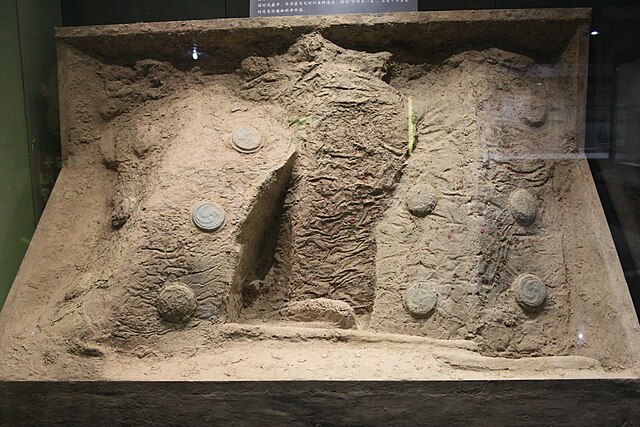The Spring and Autumn period in Chinese history lasted approximately from 770 to 481 BCE which corresponds roughly to the first half of the Eastern Zhou period. The period's name derives from the Spring and Autumn Annals, a chronicle of the state of Lu between 722 and 481 BCE, which tradition associates with Confucius. During this period, royal control over the various local polities eroded as regional lords increasingly exercised political autonomy, negotiating their own alliances, waging wars amongst themselves, up to defying the king's court in Luoyi. The gradual Partition of Jin, one of the most powerful states, is generally considered to mark the end of the Spring and Autumn period and the beginning of the Warring States period.
Leather horse armour from the Tomb of Marquis Yi of Zeng, 5th c. BC
Yue style bronze building and entertainers (Spring and Autumn period)
Shields from a Guo tomb
Urbanization during the Spring and Autumn period.
The Eastern Zhou is a period in Chinese history comprising the latter half of the Zhou dynasty from c. 771 BCE to 256 BCE, following the Zhou capital's relocation eastward to Chengzhou, near present-day Luoyang. The Eastern Zhou was characterised by the weakened authority of the Zhou royal house, it is subdivided into two parts: the Spring and Autumn period, during which the ancient aristocracy still held power in a large number of separate polities, and the Warring States period, which saw the consolidation of territory and escalation of interstate warfare and administrative sophistication.
The Eastern Zhou period
Gold sword hilt, Eastern Zhou, 6-5th century BCE. British Museum.
The Taerpo horserider, a Qin terracotta figurine from a tomb in the Taerpo cemetery near Xianyang in Shaanxi, 4th-3rd century BCE. This is the earliest known representation of a cavalryman in China. The outfit is of Central Asian style, probably Scythian, and the rider with his large nose appears to be a foreigner. King Zheng of Qin (246–221 BCE) is known to have employed steppe cavalry men in his army, as seen in his terracotta army.






